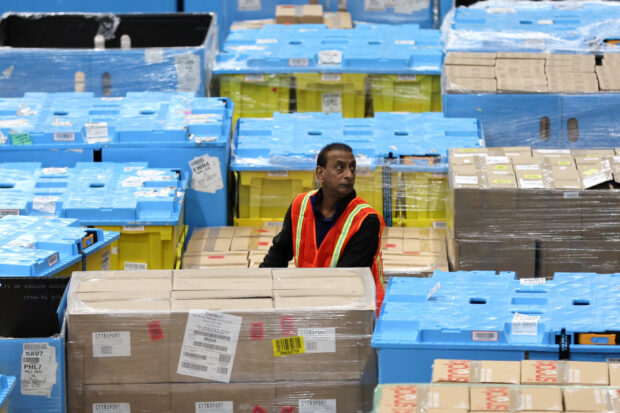
A worker moves products during Cyber Monday at the Amazon’s fulfillment center in Robbinsville, New Jersey, U.S., Nov 27, 2023. REUTERS/Mike Segar/File photo
WASHINGTON – U.S. job growth likely picked up in November as thousands of automobile workers and actors returned after strikes, but the underlying trend will probably point to a cooling labor market.
The Labor Department’s closely watched employment report on Friday, which is also expected to show wages increasing moderately and the unemployment rate unchanged at nearly a two-year high of 3.9 percent, will cement views that the Federal Reserve is done raising interest rates this cycle.
But with employment gains forecast to remain well above the 100,000 jobs per month needed to keep up with growth in the working age population, it could pour cold water on financial market expectations of the U.S. central bank pivoting to cutting rates as soon as the first quarter of 2024.
The Fed is expected to keep rates unchanged next Wednesday. It has raised its policy rate by 525 basis points to the current 5.25 percent-5.50 percent range, since March 2022.
READ: Fed keeps rates unchanged, Powell hedges on possible end of tightening
“We’re looking for more evidence that restrictive monetary policy and tight credit conditions are having the desired effect, dampening inflationary pressures, not only in the economy more broadly, but also the labor market,” said James Knightley, chief international economist at ING in New York.
“I don’t think the Fed will be signaling a desire to cut on the scale that the market is looking to price right now, but they will be pretty happy with the evidence of the cooling jobs market.”
Nonfarm payrolls likely increased by 180,000 jobs last month after rising 150,000 in October, according to a Reuters survey of economists. About 25,300 members of the United Auto Workers (UAW) union ended their strikes against Detroit’s “Big Three” car makers on Oct. 31, which depressed manufacturing payrolls that month, government data showed.
At least 5,000 UAW members remain on strike, the majority of them at Mack Trucks. Payrolls also likely got a lift from 16,000 members of the SAG-AFTRA actors union going back to work.
READ: UAW reaches deal with GM, ending strike against Detroit automakers
Still, employment gains would be less than the monthly average of 238,800 jobs this year. Demand for workers is moderating as the hefty rate hikes from the Fed curb demand in the broader economy. The government reported this week that there were 1.34 job openings for every unemployed person in October, the lowest since August 2021.
There has also been anecdotal evidence of slowing hiring, with the Fed’s Beige Book report last week describing demand for labor as having “continued to ease” and “most districts reported flat to modest increases in overall employment” from early October through mid-November.
Temporary help, a harbinger of future hiring, has declined for much of this year. The average workweek has also dropped from 34.6 hours in January to 34.3 hours in October. It is expected to have been unchanged at that level in November.
Rising labor pool
But not every economist agrees that the labor market is softening, arguing that significant portions of the economy, especially in the service sector, remain understaffed.
Indeed, an Institute for Supply Management survey this week showed services industry businesses in November reporting “issues” backfilling vacancies caused by normal attrition. There were also comments that “the labor market remains very competitive” and about “trying to get to full staff levels.”
“We’re not convinced that the labor market has really slowed abruptly here,” said Dean Maki, chief economist at Point72 Asset Management in Stamford, Connecticut. “The underlying trend in job growth remains pretty healthy.”
The unemployment rate has risen from a 53-year low of 3.4 percent in April. The increase, however, has been driven by a rise in labor supply rather than companies laying off workers. Economists said there was a risk that the jobless rate could hit 4.0% in November, but urged against interpreting the rise as a sign of deteriorating labor market conditions.
“More people are coming into the labor force, and they’re counted as unemployed when they come in,” said Dan North, senior economist at Allianz Trade North America. “It’s not companies firing people. So, it’s not the usual dynamic that would make one concerned.”
The expanding labor pool is slowing wage growth, boosting the Fed’s efforts to lower inflation to its 2 percent target.
Average hourly earnings are forecast climbing 0.3 percent after gaining 0.2 percent in October. That would lower the annual increase in wages to 4 percent, which would the smallest advance since June 2021, after rising 4.1 percent in October.
Moderate wage gains would add to recent data showing inflation ebbing in October.
While that could contribute to crimping consumer spending this quarter and beyond, economists do not expect a recession, but rather a period of tepid growth. Most did not see the economy shedding jobs until the second quarter of 2024.
“We may have some quarters of virtually flat growth, overall, very very slow growth for the whole year,” said North.

